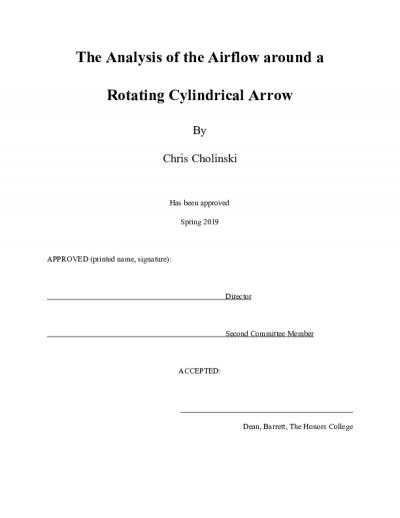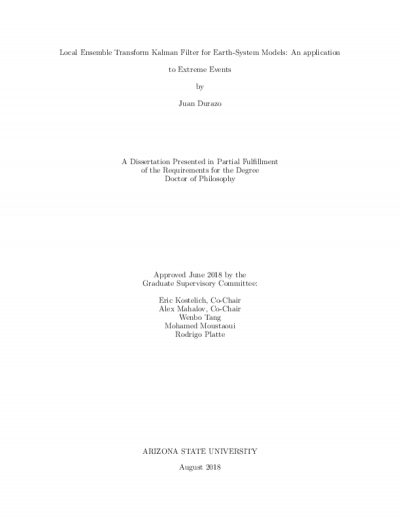Physics-Based Lidar Simulation and Wind Gust Detection and Impact Prediction for Wind Turbines

Description
Lidar has demonstrated its utility in meteorological studies, wind resource assessment, and wind farm control. More recently, lidar has gained widespread attention for autonomous vehicles.
The first part of the dissertation begins with an application of a coherent Doppler lidar to wind gust characterization for wind farm control. This application focuses on wind gusts on a scale from 100 m to 1000 m. A detecting and tracking algorithm is proposed to extract gusts from a wind field and track their movement. The algorithm was implemented for a three-hour, two-dimensional wind field retrieved from the measurements of a coherent Doppler lidar. The Gaussian distribution of the gust spanwise deviation from the streamline was demonstrated. Size dependency of gust deviations is discussed. A prediction model estimating the impact of gusts with respect to arrival time and the probability of arrival locations is introduced. The prediction model was applied to a virtual wind turbine array, and estimates are given for which wind turbines would be impacted.
The second part of this dissertation describes a Time-of-Flight lidar simulation. The lidar simulation includes a laser source module, a propagation module, a receiver module, and a timing module. A two-dimensional pulse model is introduced in the laser source module. The sampling rate for the pulse model is explored. The propagation module takes accounts of beam divergence, target characteristics, atmosphere, and optics. The receiver module contains models of noise and analog filters in a lidar receiver. The effect of analog filters on the signal behavior was investigated. The timing module includes a Time-to-Digital Converter (TDC) module and an Analog-to-Digital converter (ADC) module. In the TDC module, several walk-error compensation methods for leading-edge detection and multiple timing algorithms were modeled and tested on simulated signals. In the ADC module, a benchmark (BM) timing algorithm is proposed. A Neyman-Pearson (NP) detector was implemented in the time domain and frequency domain (fast Fourier transform (FFT) approach). The FFT approach with frequency-domain zero-paddings improves the timing resolution. The BM algorithm was tested on simulated signals, and the NP detector was evaluated on both simulated signals and measurements from a prototype lidar (Bhaskaran, 2018).
The first part of the dissertation begins with an application of a coherent Doppler lidar to wind gust characterization for wind farm control. This application focuses on wind gusts on a scale from 100 m to 1000 m. A detecting and tracking algorithm is proposed to extract gusts from a wind field and track their movement. The algorithm was implemented for a three-hour, two-dimensional wind field retrieved from the measurements of a coherent Doppler lidar. The Gaussian distribution of the gust spanwise deviation from the streamline was demonstrated. Size dependency of gust deviations is discussed. A prediction model estimating the impact of gusts with respect to arrival time and the probability of arrival locations is introduced. The prediction model was applied to a virtual wind turbine array, and estimates are given for which wind turbines would be impacted.
The second part of this dissertation describes a Time-of-Flight lidar simulation. The lidar simulation includes a laser source module, a propagation module, a receiver module, and a timing module. A two-dimensional pulse model is introduced in the laser source module. The sampling rate for the pulse model is explored. The propagation module takes accounts of beam divergence, target characteristics, atmosphere, and optics. The receiver module contains models of noise and analog filters in a lidar receiver. The effect of analog filters on the signal behavior was investigated. The timing module includes a Time-to-Digital Converter (TDC) module and an Analog-to-Digital converter (ADC) module. In the TDC module, several walk-error compensation methods for leading-edge detection and multiple timing algorithms were modeled and tested on simulated signals. In the ADC module, a benchmark (BM) timing algorithm is proposed. A Neyman-Pearson (NP) detector was implemented in the time domain and frequency domain (fast Fourier transform (FFT) approach). The FFT approach with frequency-domain zero-paddings improves the timing resolution. The BM algorithm was tested on simulated signals, and the NP detector was evaluated on both simulated signals and measurements from a prototype lidar (Bhaskaran, 2018).
Date Created
The date the item was original created (prior to any relationship with the ASU Digital Repositories.)
2019
Agent
- Author (aut): Zhou, Kai
- Thesis advisor (ths): Calhoun, Ronald
- Committee member: Chen, Kangping
- Committee member: Tang, Wenbo
- Committee member: Peet, Yulia
- Committee member: Krishnamurthy, Raghavendra
- Publisher (pbl): Arizona State University







